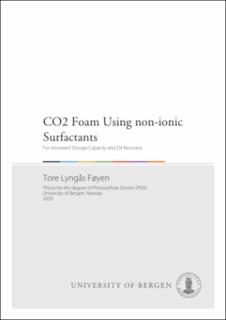CO2 Foam Using non-ionic Surfactants : For Increased Storage Capacity and Oil Recovery
Doctoral thesis
Permanent lenke
https://hdl.handle.net/11250/2760796Utgivelsesdato
2020-12-18Metadata
Vis full innførselSamlinger
Sammendrag
Large-scale carbon capture and storage is needed to achieve the target set forward by the Paris agreement; to limit global warming to 1.5 °C. The primary obstacle for implementing large-scale carbon capture and storage is the high economical cost. Utilization of CO2 as a commodity in production processes, commonly called carbon capture and utilization (CCUS), can establish a CO2 value-chain and provide economic incentives. A promising use of CO2 is for enhanced oil recovery (EOR). Additional oil can be recovered from oil reservoirs by injecting CO2; simultaneously, CO2 is stored in the subsurface. CO2-EOR is field-proven, however, it has primarily been implemented using non-anthropogenic CO2. The potential economic revenue by establishing a CO2 value-chain with CO2-EOR, using anthropogenic CO2 have yet been insufficient for the industry.
CO2-EOR has inherent challenges due to the viscosity and density differences between reservoir fluids and the injected CO2, potentially leading to poor sweep efficiency. Poor sweep efficiency is detrimental to oil recovery and CO2 storage. Providing technological solutions that tackle the sweep efficiency issues can potentially make CO2-EOR feasible and catalyze the implementation of large-scale carbon capture and storage. Foam is a technological solution that decreases the mobility of CO2 and increases sweep efficiency. This thesis presents a multi-scale investigation of foam for CO2 mobility control stabilized using non-ionic surfactants. The study includes investigations from pore-scale foam dynamics to field-scale implementation of CO2-foam injection, with an emphasis to produce oil from mature field with a reduced carbon footprint.
The thesis consists of five chapters. Chapter 1 provides an introduction and a rationale for the research questions addressed in this thesis, whereas Chapter 2 provides a theoretical background of fundamental concepts of foam in porous media. Chapter 3 summarizes the experimental methods and clarifies how the experiments relate to each other. Chapter 4 presents key findings from the five publications, emphasizing synergetic results from published work, and is organized into individual foam-subjects.
Består av
Paper 1: Føyen, T., Benali, B., Haugen, M., Gauteplass, J., Kovscek, A.R., Fernø, M.A. Pore-scale Bubble Population Dynamics of CO2-Foam. The article is not available in BORA.Paper 2: Føyen, T., Brattekås, B., Fernø, M.A., Barrabino, A., Holt, T. Increased CO2 storage capacity using CO2 -foam. International Journal of Greenhouse Gas Control. Volume 96, 2020, 103016. The article is available at: https://hdl.handle.net/11250/2738397
Paper 3: Alcorn, Z.P., Føyen, T., Gauteplass, J., Benali, B., Soyke, A., Fernø, M.A. Pore- and core-scale insights of nanoparticle-stabilized foam for CO2 enhanced oil recovery, Nanomaterials. Volume 10(10), 2020, 1917. The article is available at: https://hdl.handle.net/11250/2738022
Paper 4: Føyen, T.,Alcorn, Z.P., Fernø, M.A., Barrabino, A., Holt, T.CO2 mobility reduction using foam stabilized by CO2- and water-soluble surfactants. Journal of Petroleum Science and Engineering. Volume 196, 2020, 107651. The article is available at: https://hdl.handle.net/11250/2738392
Paper 5: Alcorn, Z.P., Føyen, T., Zhang, L., Karakas, M., Biswal, L., Hirasaki, G., Graue, A. CO2 foam field pilot design and initial results. Proceeding at SPE Improved Oil Recovery Conference, Tulsa, Oklahoma, USA, Aug 31st to Sept 4th 2020. The article is not available in BORA due to publisher restrictions. The published version is available at: https://doi.org/10.2118/200450-MS

